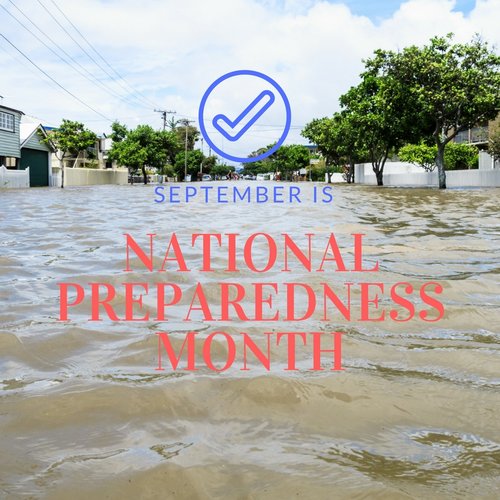Frontline Blog
In Houston, Flood Response Success is about Taking the Long View
September 2016
September is National Preparedness Month, so we asked the City of Houston, a Big Cities Health Coalition member, to share the lessons learned from their 2016 “Tax Day Day Flood.” How did the public health department assist Houston residents, and did they consider their job done once the streets were dry?
by Raouf R Arafat, MD,MPH, Assistant Director, Houston Health Department
From April 16-18, 2016, the Houston area experienced widespread flooding. First responders conducted 1,200 high-water rescues; over 6,700 houses were damaged in the region; overall property damage was estimated at $5 billion. Eight residents perished when their vehicles were trapped in high water. Four months later, Houston Health Department employees are still attempting to address the needs of flood victims through long-term case management.

As civilians, we have become accustomed to hearing about natural and man-made disasters. We hear—or perhaps we even tune out media soundbites that deliver a cascade of disaster numbers. It has been said that “statistics is human beings with the tears wiped away.”
As public health professionals, we are surrounded by numbers too. Data help us plan our responses to events that threaten our community’s health. These events could be epidemics, weather related, or man-made disasters. Also, management decisions are made, funding is allocated, and program performance is analyzed based on the measurable outcomes we achieve when protecting our community’s health.

To understand the magnitude of Houston’s Tax Day Floods and the Houston Health Department’s response to it we have to analyze the numbers. Almost 2,000 apartments were damaged in Houston’s Greenspoint neighborhood alone. However, to communicate the magnitude of our response we have to re-insert the human element.
The story I wish to tell about our Tax Day Flood response—the story “behind the headlines”—is as much qualitative as it is quantitative. The Health Department’s employees who responded to the flood not only served thousands of Houstonians, but they showed tremendous dedication, resourcefulness, and professionalism during their deployment. They were motivated by a desire to help the flood victims get back on their feet and live with dignity. They saw flood victims as people, not as numbers.
The Houston Health Department mobilized its disaster response teams shortly after the flood waters began to recede. Over 100 employees were deployed to the Houston Emergency Center, apartment complexes in the hardest-hit areas, and interim shelters and hotels that housed evacuees. They engaged in various activities ranging from managing and planning the response, distributing food and clothing, processing displaced persons, providing nursing triage at interim shelters, and conducting interviews and assessments.
Jeff Floyd served as one of the Health Department’s Public Health Liaisons at the Houston Emergency Center. Mr. Floyd’s primary role was to help the Health Department make strategic decisions about food, medical care, and social service needs based on reports he received from Health Department staff deployed in the field. He performed these duties for several days, working 12-hour shifts in close collaboration with other municipal entities under the umbrella of the Incident Command System, or ICS.
Despite being on the planning side of the Health Department’s efforts, Jeff Floyd was keenly aware that the goal of the Tax Day Flood Response, ultimately, was to “protect the dignity of Houstonians by placing them in better living conditions.” In other words, the goal wasn’t simply to meet the flood victims’ immediate basic needs and discharge them from the shelter once the flood water receded. Rather, the goal was to get them to a better place–literally and figuratively—by looking at the flood victims in a holistic manner.
For several days, Jeff Floyd was at the Houston Emergency Center analyzing field reports from his Health Department colleagues to help Incident Command develop a clearer picture of the flood damage and peoples’ emerging needs. Based on this data, the Health Department deployed Rapid Assessment and Service Response teams to extremely hard hit areas, such as Houston’s Greenspoint and Chateau Forest neighborhoods. They also deployed to temporary shelters and hotels to identify and address the victims’ needs.
Throughout the Tax Day Flood response, Health Department Rapid Assessment Teams conducted a total of 2,563 interviews with residents to determine their needs for shelter, food, medical care, mental health services, and basic necessities. Once completed, these assessments were routed to the Health Department’s Service Response Team to provide follow-up, referrals and other assistance.
Roy Villareal was one of the many Health Department staff who deployed with the Rapid Assessment Team after the storm. As a Health Department employee for 11 years, Mr. Villareal has deployed with several of the Health Department’s Assessment, Intervention, and Mobilization, or AIM, initiatives. AIMs are large-scale events where Health Department staff use the Incident Command System to plan and manage large-scale community assessments. In times of disaster such as the Tax Day Floods, the AIM model is integrated into the Health Department’s emergency response and placed under ICS command.
Once the rains began, Mr. Villareal knew that he and several members of his staff would likely be activated if flooding was widespread. When he received the call, Mr. Villareal and his staff were able to deploy to the Greenspoint neighborhood within 24 hours. He reasoned that this quick deployment was due to the fact that his staff was well trained in the Incident Command Structure and AIM operations. They were prepared.
For two weeks after the flood Mr. Villareal supervised Rapid Assessment Teams. They assessed hundreds of individuals at apartment complexes, shelters, and hotels. While he is a veteran of these deployments, Mr. Villareal nevertheless was struck by the level of “despair and trauma” he witnessed while interviewing flood victims. He was overwhelmed at times by the complex needs that many evacuees presented. They lost everything; they felt they had nowhere to go. They were traumatized.
He also explained that these assessment interviews were hard on staff. Mr. Villareal took steps to make sure his team members were practicing self-care. They de-briefed regularly to process their feelings about what they witnessed.
Through its Care Coordination Team, the Houston Health Department continues to provide long-term case management to a number of the hardest-hit flood victims. As much as any data, the fact that our staff continue to respond to the Tax Day Flood months after the waters have receded demonstrates the extent of their dedication, as well as the long term effects of disasters. True disaster recovery can only take place when public health professionals work as a team on the larger response and recovery activities and address the whole person’s needs with compassion, professionalism, and an ongoing commitment to helping survivors live with dignity.